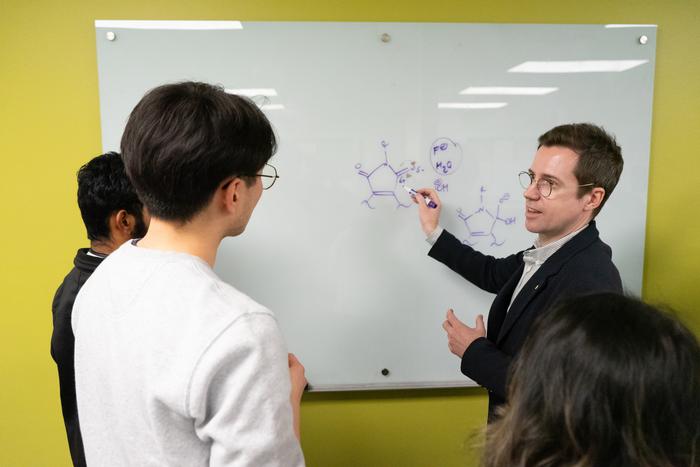In a groundbreaking advancement poised to reshape the landscape of sustainable chemical manufacturing, researchers at Colorado State University (CSU) have unveiled an innovative light-driven catalytic process that dramatically enhances the efficiency of transforming fossil fuel derivatives into valuable modern chemicals. This pioneering method, published in Science, harnesses the power of visible light to facilitate super-reducing organic photoredox catalysis at room temperature, a feat that promises to significantly reduce the energy footprint and environmental impact traditionally associated with these chemical transformations.
Led by Professors Garret Miyake and Robert Paton, the research centers on a novel photoredox catalytic system that ingeniously mimics natural photosynthesis. Unlike conventional catalytic techniques that typically rely on high heat or harsh reagents, this system utilizes visible light photons to initiate and drive chemical reactions. By absorbing two photons sequentially, the catalyst accumulates sufficient energy to perform super-reducing reactions—processes that require breaking some of the most resilient bonds in organic molecules. This dual-photon mechanism circumvents the inherent energy limitations of single-photon systems, unlocking new reaction pathways previously inaccessible under mild conditions.
One of the most remarkable aspects of this discovery is its ability to effectively reduce aromatic hydrocarbons, or arenes, a notoriously challenging class of chemical compounds due to their stable, resonance-stabilized ring structures. These arenes, such as benzene rings commonly found in fossil fuels, serve as fundamental building blocks for an array of indispensable chemicals including plastics, pharmaceuticals, and agrochemicals. Traditionally, converting arenes into more functionalized compounds demands substantial energy input, often achieved through high-temperature catalysis or the use of aggressive reagents, resulting in considerable environmental burden. The CSU team’s light-based method offers a gentler yet highly efficient alternative with significant implications for both industrial chemistry and sustainability.
.adsslot_YlIP6R78d5{ width:728px !important; height:90px !important; }
@media (max-width:1199px) { .adsslot_YlIP6R78d5{ width:468px !important; height:60px !important; } }
@media (max-width:767px) { .adsslot_YlIP6R78d5{ width:320px !important; height:50px !important; } }
ADVERTISEMENT
At the core of this catalytic process is its strategic use of proton-coupled electron transfer (PCET), a sophisticated mechanism that mitigates the challenge of back electron transfer, which typically quenches efficiency in photoredox catalysis. By coupling electron transfers with proton shifts, the catalyst stabilizes reactive intermediates and extends their lifetimes, facilitating effective bond cleavage and electron addition. This mechanistic innovation allows the catalyst to maintain its super-reducing power throughout the reaction, a critical factor in achieving the high efficiencies reported.
This research is set against the backdrop of the U.S. National Science Foundation’s Center for Sustainable Photoredox Catalysis (SuPRCat), a multi-institutional initiative directed by Miyake, aimed at revolutionizing chemical synthesis through the integration of synthetic chemistry and computational insights. The center’s concerted efforts focus on developing catalytic systems capable of addressing urgent sustainability challenges, including the efficient synthesis of ammonia fertilizers, remediation of persistent environmental pollutants like PFAS, and innovative pathways for the upcycling of polymers.
Katharine Covert, program director for the NSF Centers for Chemical Innovation, emphasizes the transformative impact of photoredox catalysis on pharmaceutical development and wider chemical industries. Through collaborative efforts within the SuPRCat framework, the deeper understanding of catalyst functionality has enabled the pioneering of less energy-intensive synthetic routes, exemplified by the CSU team’s reported breakthrough. The confluence of synthetic innovation and theoretical modeling underscores a new paradigm in catalysis design, promising continued advancement in green chemistry.
Beyond the technical merits, the researchers highlight an urgent call to action concerning the global chemical industry’s environmental footprint. Miyake underlines the pressing timeline humanity faces in transitioning towards sustainable technologies, asserting that innovative approaches like theirs are indispensable to averting irreversible ecological damage. The team’s collective expertise and interdisciplinary collaboration stand as a testament to the caliber required to meet such formidable challenges, heralding a future where chemical manufacturing harmonizes with environmental stewardship.
This pioneering study also featured contributions from notable researchers including University of Colorado Boulder Professor Niels Damrauer and CSU team members Amreen Bains, Brandon Portela, Alexander Green, Anna Wolff, and Ludovic Patin. Their combined expertise in organic synthesis, computational chemistry, and catalysis underpins the robustness and broad applicability of the developed system.
Looking ahead, the team is actively expanding this photoredox platform to tackle a wider array of chemical transformations crucial for sustainable development. Applications under exploration include the sustainable production of ammonia, a cornerstone fertilizer in global agriculture; strategic degradation of PFAS chemicals, which persist as pervasive environmental contaminants; and advanced chemical recycling methods aimed at mitigating plastic waste through polymer upcycling. These ambitious goals position the research at the interface of chemistry, environmental science, and societal needs, highlighting its broad relevance and transformative potential.
In conclusion, the CSU-led team’s research presents a landmark advancement in organic photoredox catalysis, offering a potent combination of energy efficiency, environmental sustainability, and chemical versatility. By leveraging the synergistic effects of proton-coupled electron transfer and innovative light absorption strategies, this new catalytic system sets a precedent for future developments in sustainable chemical manufacturing, inspiring hope for a more resilient and eco-conscious industrial future.
Subject of Research: Organic photoredox catalysis for sustainable chemical transformations
Article Title: Efficient super-reducing organic photoredox catalysis with proton-coupled electron transfer–mitigated back electron transfer
News Publication Date: 19-Jun-2025
Web References:
DOI link to article
CSU Center for Sustainable Photoredox Catalysis
U.S. National Science Foundation Center for Sustainable Photoredox Catalysis at CSU
Prof. Robert Paton contact
References:
Paton, R. S., Miyake, G. M., et al. (2025). Efficient super-reducing organic photoredox catalysis with proton-coupled electron transfer–mitigated back electron transfer. Science. DOI: 10.1126/science.adw1648.
Image Credits: Colorado State University College of Natural Sciences
Keywords
Catalysis, Sustainability, Chemistry, Photosynthesis, Chemical compounds, Organic chemistry, Hydrocarbons, Fossil fuels, Fertilizers, Pollution, Redox reactions, Organic reactions
Tags: advanced materials chemistryColorado State University researchdual-photon mechanism in catalysisenergy-efficient chemical transformationsenvironmental impact of chemical processesgreen chemistry solutionsinnovative catalytic systemsorganic photoredox catalysisphotosynthesis-inspired technologyreducing aromatic hydrocarbonssustainable chemical manufacturingvisible light-driven reactions





